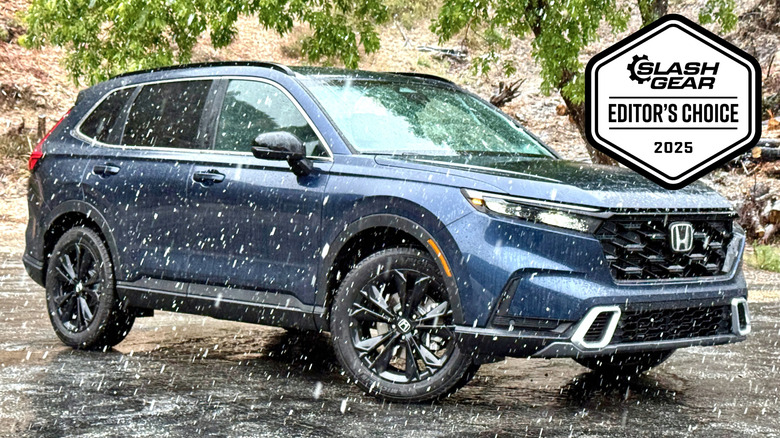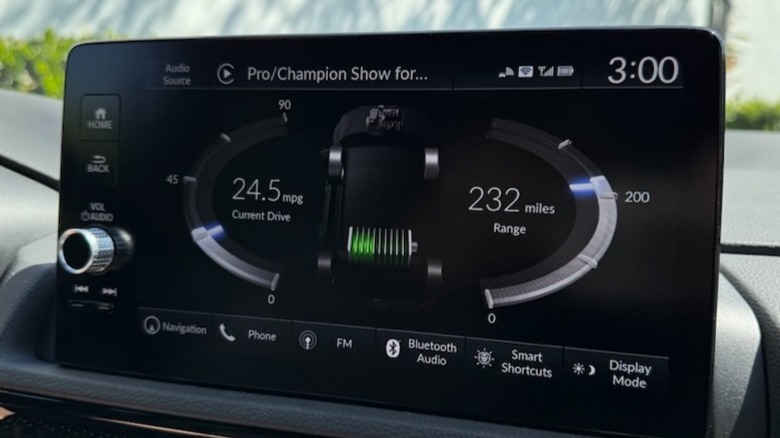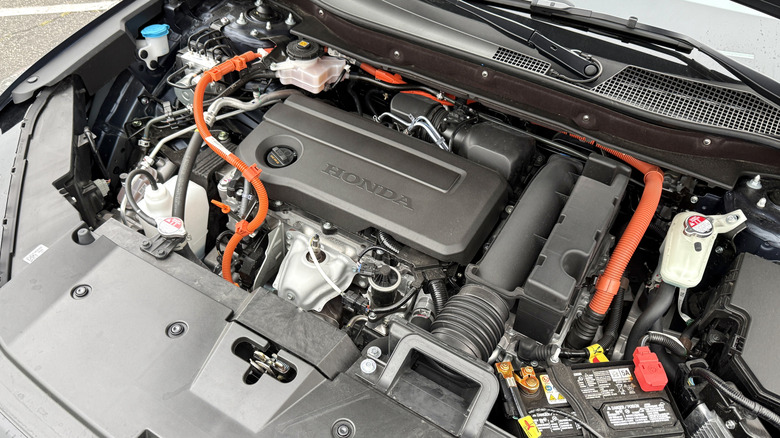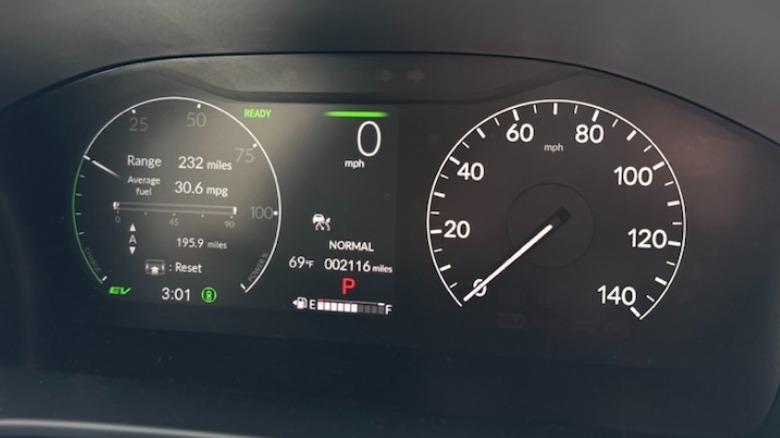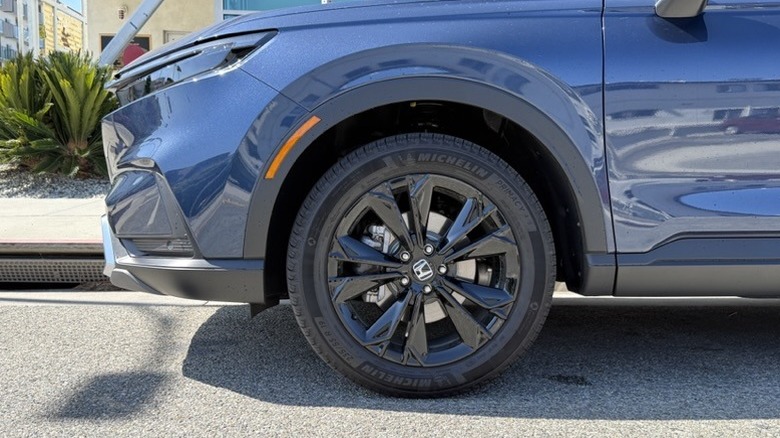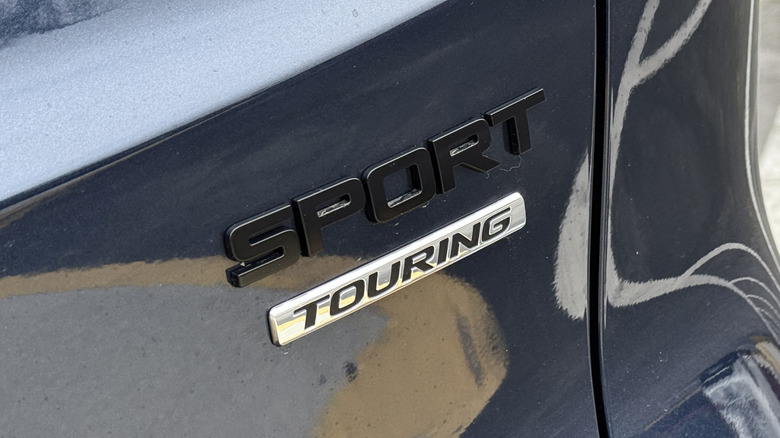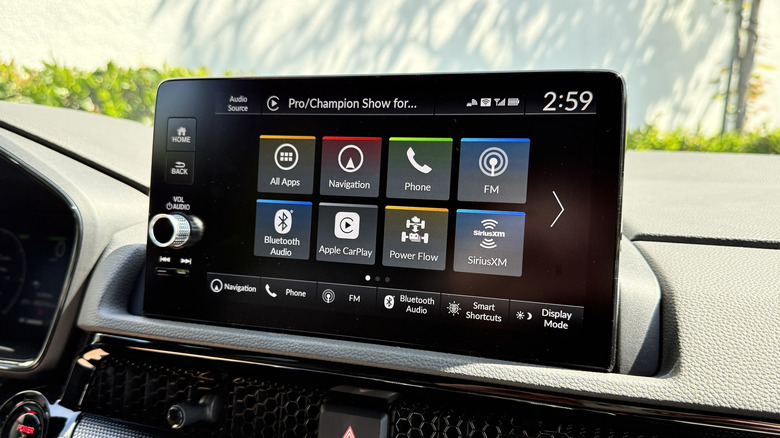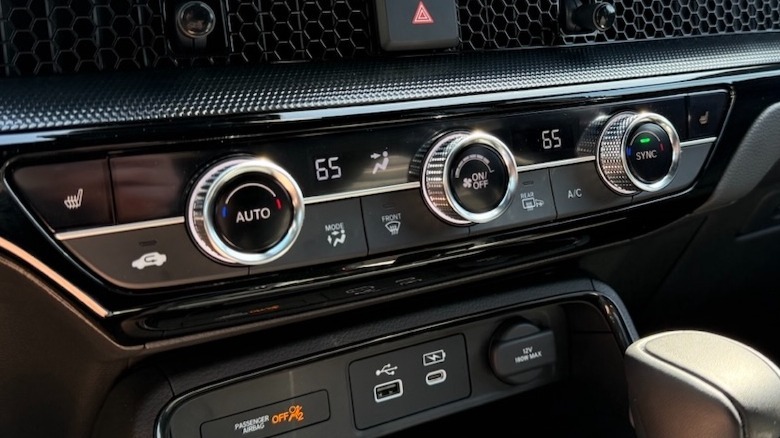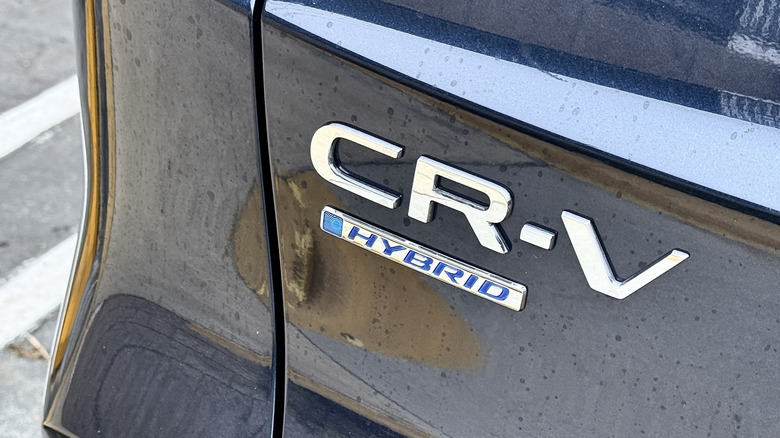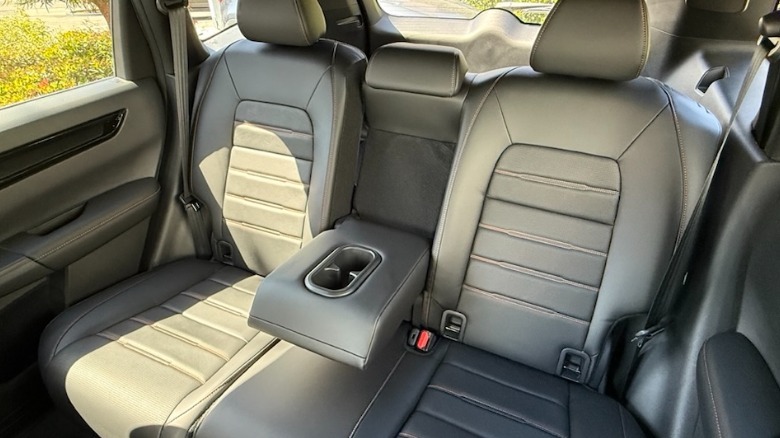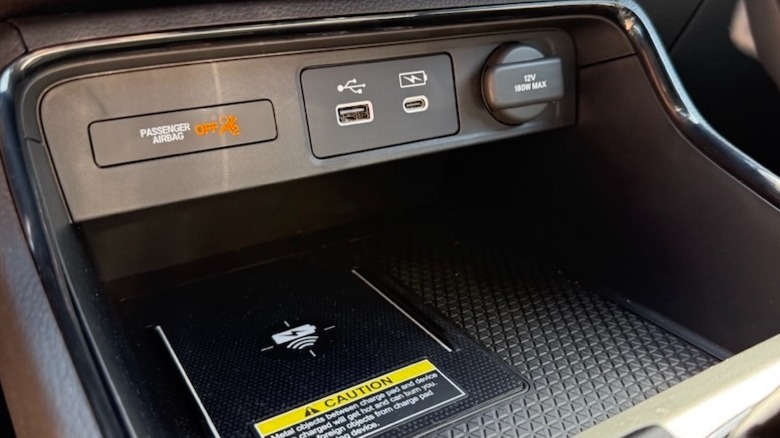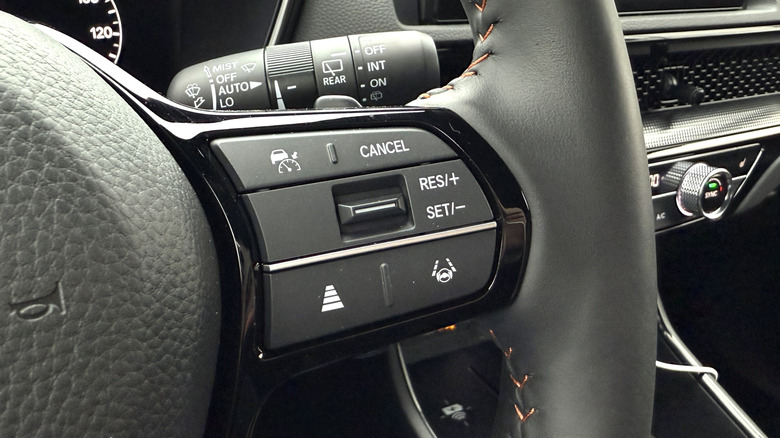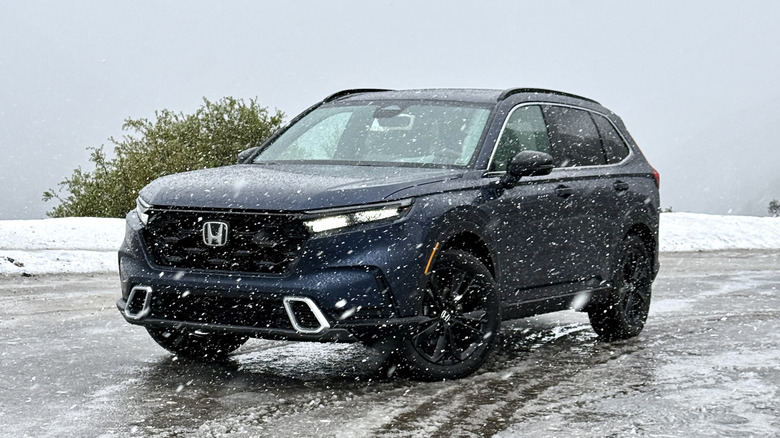2025 Honda CR-V Hybrid Review: Sport Touring Is Capable But MPG Falls Short
- Strong power and torque from hybrid powertrain
- Comfortable and quiet interior
- Plenty of passenger room and cargo space
- Wide variety of trim levels
- Finicky driver aids
- Fuel economy estimates are optimistic
- No available plug-in option
Honda doesn't make a plug-in hybrid CR-V, at least not one that you can fill up at a traditional gasoline pump. Sure, there's the CR-V e:FCEV that's powered by a combination of hydrogen and electrons, but it's only available in California and it can't be purchased, only leased.
The standard CR-V Hybrid is more mainstream. It runs on gas but it also uses a two-motor hybrid system to augment power, performance, and fuel economy. The lack of EV range, however, puts the CR-V at a disadvantage against rivals like the RAV4 and the Sportage, both of which are offered with plug-in hybrid powertrains.
The CR-V isn't exactly stumbling back on its heels though. Decades into its run as one of the top compact SUVs, the CR-V still has a lot going for it. Even without the plug-in hybrid powertrain, it still has an efficient standard hybrid, impressive driving dynamics, and one of the most comfortable interiors in the class. But is that enough to keep it competitive against rivals from Toyota and Kia?
A simple powertrain structure
There are two different powertrains available for the 2025 Honda CR-V. The base engine is a turbocharged 1.5-liter four-cylinder that puts out 190 horsepower and 179 lb-ft of torque. It has enough power to be entertaining, but it's not exactly a hot rod. The hybrid powertrain is definitely the more lively of the two and it's the one Honda loaned me for a week of testing: specifically the Hybrid Sport Touring, the top available trim level.
Every CR-V Hybrid uses a 2.0-liter four-cylinder engine, paired with a two-motor hybrid system. We'll talk more about the trim levels below, but for now what's important to know is that combined output of the hybrid powertrain is 204 hp and 247 lb-ft of torque. Even though it has a relatively small horsepower increase (just 14 hp) compared to the standard model, the hybrid's torque advantage is massive. And a big benefit of that extra torque is where it's delivered, peaking below 2,000 rpm.
That means it's quick to accelerate from a stop, and it feels like it has a sense of urgency on throttle tip in, without being lurchy or sensitive. It may not have any all-electric range, but the CR-V is still an excellent city car with plenty of power down low. On long uphill grades the engine does have a bit of an unpleasant drone, but in pretty much every other scenario it's quiet and easy going.
Comfort and handling
After a few days in the CR-V Hybrid, I kept coming back to the same word, again and again: composed. No matter what scenario I was driving in, or what kind of road I was driving on, the CR-V felt composed. In corners, it felt capable and unbothered. Even in the uncharacteristically wet (and snowy) weather California was experiencing late this spring, the CR-V was confident around curves. Sure, there was a bit of body roll, but the steering felt well weighted and the handling was impressive for an SUV. CR-V trims with the hybrid powertrain get larger front and rear sway bars which help handling a bit as well.
On the highway, the CR-V was quiet and well-mannered. It had a smooth ride over the bumpy bits thanks to a well-tuned suspension that uses MacPherson struts up front and multi-link setup in the rear. The Sport Touring trim level gets 19-inch wheels (compared to 18's and 17's on lower trims) which I initially thought might affect the ride quality a bit, but that wasn't the case. The tires wrapped around the 19's have enough sidewall to absorb most of the small road impacts; lower trim levels with the smaller wheels will likely be even better.
Pricing out the book-end models
There are six total CR-V trim levels: LX, EX, Sport, EX-L, Sport-L, and Sport Touring. LX, EX, and EX-L all get the 1.5-liter engine and everything else is hybrid-powered. And, with the exception of Sport Touring, every other CR-V has the choice between front-wheel drive and all-wheel drive.
Base CR-V models like the LX start at $31,495 (including $1,395 destination fee) and come with the features like power windows, manually adjustable seats, and smartphone connectivity. The big set of features worth mentioning though, is called Honda Sensing: the CR-V's suite of driver aids. It includes forward collision warning, road departure mitigation, lane departure warning, adaptive cruise control, lane-keep assist, and traffic jam assist on every trim level. Blind spot monitoring and a cross-traffic monitor are standard on EX-and-above. Parking sensors and low-speed braking control are pretty much all that's left, and those come standard on EX-L, Sport-L, and Sport Touring models.
The CR-V I drove around for a week was the most expensive version you can buy, the Sport Touring Hybrid, with an MSRP of $42,495. It comes standard with all-wheel drive and all sorts of other creature comforts like a premium stereo, navigation, Wi-Fi hotspot capability, a heated steering wheel, and a power tailgate with hands-free operation. Thankfully, if you don't want to shell out for the Sport Touring Hybrid, there's a lot of room below it.
What's between LX and Sport Touring?
Apple CarPlay and Android Auto connectivity are standard on the base LX trim along with Honda's 7-inch center touchscreen. On EX-L, Sport-L, and Sport Touring trims though, you get the larger 9-inch display, wireless connectivity for smartphones, a wireless charging pad, satellite radio, leather upholstery, and an auto-dimming rearview mirror.
Audio systems with four, six, and eight speakers are all available on lower trims, but an impressive Bose 12-speaker stereo comes standard on the Sport Touring. It's not the only reason to upgrade to the top trim, but the Bose system is pretty impressive for the class, with a big volume range and better-than-decent audio quality.
Essentially, anywhere between the base price of $31,495 and the Sport Touring price of $42,495, there's a trim with some version of the equipment you're looking for. There are some missing features the CR-V just doesn't get like ventilated seats, but otherwise, most shoppers should be able to find a sweet spot.
Fuel economy in the real world
According to the EPA, the standard 1.5-liter powertrain on the non-hybrid CR-V will return as high as 30 mpg combined (28 city/34 highway) on front-wheel drive models. All-wheel drive drops that estimate to 28 mpg combined. The hybrid takes a pretty big leap, with the EPA estimating a return of 37 mpg combined (40 city/34 highway) with all-wheel drive models and 40 mpg combined (43 city/36 highway) on front-wheel drive models. That's enough to edge out the Toyota RAV4 Hybrid's best rating (39 mpg combined), but not the top Kia Sportage Hybrid, which checks in at 43 mpg combined, according to the EPA.
During my time with the all-wheel drive Sport Touring model, I averaged around 31 mpg. That's not bad for a city like Los Angeles that's packed with traffic on such a regular basis, but it falls well below the EPA's ratings. This isn't an isolated incident either. When we drove the redesigned CR-V back in 2023, it didn't meet EPA expectations at that time either. Some real-world mileage differences can be attributed to driving style and conditions, but there's a significant gap between what Honda is promising and what the CR-V hybrid is delivering.
A high quality interior with room to spread out
Like lots of Honda SUVs, the CR-V's center console is big, with lots of storage for all your spare water bottles or digital devices – though I wouldn't put both of them in there at the same time. The front seats have impressive comfort over long distances and there's enough bolstering to keep you in place along a local mountain pass. The back seat is wide enough to seat three adults in relative comfort over short distances too.
Behind the rear seats, the standard CR-V offers 39.3 cubic feet of cargo space, which puts it right at the top of the class. That number does drop slightly in the hybrid to 36.3 cubic feet, and down to 34.7 cubic feet with the Sport Touring, but there's still plenty of room for your luggage. The RAV4 Hybrid offers 37.5 cubic feet, while the CX-50 has just 29.2 cubes and the Kia Sportage Hybrid has an impressive 39.5 cubic feet.
The CR-V's interior feels relatively premium, even if it does lack the near-luxury feel that you can get in rivals like the Mazda CX-50. The steering wheel controls are relatively intuitive, falling easily to hand. There isn't much of a learning curve with Honda products like the CR-V: even if it's been a while since I've sat behind the wheel, it's easy to figure out Honda button placement. The dashboard is simply laid out, without unnecessary aesthetic touches or redundant commands.
Some issues with the driver aids
The CR-V offers a lot of standard safety equipment, and having features like adaptive cruise control and lane-keep assist on even the most basic version of the CR-V is a plus. Low speed braking control and parking sensors are noteworthy additions on upper trims too. Unfortunately, during my test of the CR-V there were lots of beeps and noises from the various driver aids, distracting from the driving experience.
More than once I received a false alarm from the blind-spot monitoring system when changing lanes, as the CR-V would detect a vehicle one or two lanes away. Highway merging certainly becomes more stressful when your vehicle thinks there's a car hanging out in your blind spot, but it's really two lanes over. Similar alerts were set off when vehicles changed lanes or slowed down in front of me, setting off the CR-V's forward collision warning. With most of the CR-V's driving aids, there's no clear way to adjust the sensitivity.
2025 Honda CR-V Hybrid Verdict
The driver aids may be over-sensitive, but driving the 2025 CR-V Hybrid is otherwise a pleasant experience. Whether it's daily commuting, twisty mountain roads, or long highway trips while the kids are out of school for the summer, the CR-V has something for everyone. It offers an impressive balance of capability, efficiency, and fun, all in a package that's reasonably priced. Real-world fuel economy numbers weren't as impressive as I'd like, but a lighter foot could probably get me closer to the EPA's high estimates.
We reviewed the RAV4 Hybrid earlier this year and it was certainly appealing, but the CR-V feels more modern and refined. Plug-in hybrid variants like the RAV4 Plug-In Hybrid offer a bit of EV range, but there's a price premium to pay up front. The Mazda CX-50 is another compelling choice in the class, offering sharper steering and handling, along with sleek styling. The CR-V is a bit more practical though, with more room for passengers and cargo. The CR-V certainly has some stiff competition, but few rivals are as well rounded so the Honda continues to stand out in a crowded field.
